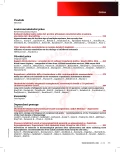Blood Donor Registry – comparison of data from 12 blood transfusion services: 2008 versus 2016
Authors:
P. Turek 1; A. Lerlová 1; J. Bělochová 2; E. Pintová 2; D. Dušková 3; M. Bohoněk 4; V. Řeháček 5; J. Černohorská 5; P. Šlechtová 6; J. Jedlička 6; Z. Čermáková 7; J. Masopust 8; J. Pelková 9; L. Bartošová 10; J. Zítková 11; P. Kessler 12; M. Harudová 12
Authors‘ workplace:
Transfuzní oddělení, Thomayerova nemocnice, Praha
1; Transfuzní oddělení, FN Královské Vinohrady, Praha
2; Fakultní transfuzní oddělení, Všeobecná fakultní nemocnice, Praha
3; Oddělení hematologie a krevní transfuze, Ústřední vojenská nemocnice, Praha
4; Transfuzní oddělení, Fakultní nemocnice Hradec Králové, Hradec Králové
5; Transfuzní oddělení, Fakultní nemocnice Plzeň, Plzeň
6; Krevní centrum, Fakultní nemocnice Ostrava, Ostrava
7; Transfuzní oddělení, Masarykova nemocnice, o. z., Krajská zdravotní, a. s., Ústí nad Labem
8; Hematologicko-transfuzní oddělení, Krajská nemocnice T. Bati, a. s., Zlín
9; Hematologicko - transfuzní oddělení, Oblastní nemocnice Kladno, a. s., Kladno
10; Transfuzní oddělení, Klatovská nemocnice, a. s., Klatovy
11; Oddělení hematologie a transfuziologie, Nemocnice Pelhřimov, p. o., Pelhřimov
12
Published in:
Transfuze Hematol. dnes,24, 2018, No. 4, p. 262-268.
Category:
Original Papers
Overview
Given the current organisation of blood transfusion services in the Czech Republic, information regarding donor ca - tegories, frequency of donations and representation of individual types of donation or donor age is scant. Even these basic data are difficult to interpret as far as some of the information is concerned. More detailed information regarding the number of donors of different categories, frequency of donations, age and blood type is missing.
In this study, 12 independent blood transfusion services (BTS) of different types (university or regional hospitals, small county hospitals) and from different regions were asked to provide well defined sets of information (based on the format of the EU DOMAINE project) regarding donors in their registries in 2008 and 2016 with the aim of identifying trends and predicting future options. The selected BTS perform nearly 1/3 of all blood collections in the country, thus providing a robust sample.
In general, there was a slight increase in blood donations, whereby slightly more persons donated blood in selected BTS in 2016 compared to 2008. This increase does not indicate an increased activity of transfusion services in the Czech Republic as a whole, but rather reflects the gradual yet slight centralisation of whole blood collection and processing. Over the same period, the number of first-time donors dropped and the proportion of first-time donors decreased. The mean age of active blood donors and even the mean age of first-time donors have increased significantly. This negative trend may represent a risk for blood transfusion services in the future. These services should thus react appropriately to guarantee an adequate supply of blood components and national self-sufficiency in the future.
Key words:
blood donation – blood donor registries – Czech Blood Transfusion Service
Sources
1. de Kort W, Veldhuizen I. Donor Management Manual. Nijmegen, The Netherlands, DOMAIN project 2010. Dostupné na www: http://www.europeanbloodalliance.eu/downloads/eba-manuals/
2. de Kort W. Donor management: DOMAINE – the European perspective; ISBT Science Series 2010;5 : 201–205.
3. Turek P, Lerlová A. Analýza registru dárců vybraných ZTS v ČR; 12. pracovní dny v transfuzním lékařství, Sborník abstrakt, Olomouc 2009.
4. Turek P. Činnost nemocniční transfuzní služby v České Republice v roce 2008. Transfuze Hematol Dnes 2009;15 : 178–181.
5. MZ ČR: zpráva o činnosti zařízení transfuzní služby 2016. Dostupné na www: http://www.mzcr.cz/Odbornik/dokumenty/zprava-o-cinnosti-zarizeni-transfuzni-sluzby-za-rok-2016_14621_1952_3.html.
6. Veldhuizen I, Follea G, de Kort W. Donor cycle and donor segmentation: new tools for improving blood donor management. Vox Sanguinis 2013;105 : 28–37.
7. Duboz P, Cuneo B: How barriers to blood donation differ between lapsed donors and non-donors in France. Transfus Med 2010;20 : 227–236.
8. Lemmens KP, Abraham C, Ruiter RA, et al. Modelling antecendents of blood donation motivation among non-donors of varying age and education, Br J Psychol 2009;100 : 71–90.
9. Rada Evropy: Report on the collection, testing and use of blood and blood components in Europe. Dostupné na www: https://www.edqm.eu/sites/default/files/report-blood-and-blood-components-2014.pdf.
10. Český statistický úřad, Demografické ročenky. Dostupné na www: https://www.czso.cz/csu/czso/casova_rada_demografie.
Labels
Haematology Internal medicine Clinical oncologyArticle was published in
Transfusion and Haematology Today

2018 Issue 4
Most read in this issue
- Hypercalcemia may be the first sign of multiple myeloma, but not only that
- Prevention of infection in haematological patients after splenectomy and those suffering from hypersplenism: recommendations of the CzEch Leukemia Study Group for Life (CELL
- Long-term results of allogeneic stem cell transplantation in 533 patients: a single centre experience
- Long-term storage and disposal of cryopreserved grafts – recommendations of the Transplant Section of the Czech Society of Haematology
